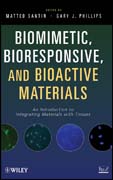
Biomimetic, bioresponsive, and bioactive materials: an introduction to integrating materials with tissues
Santin, Matteo
Phillips, Gary J.
The accessible introduction to biomaterials and their applications in tissue replacement, medical devices, and more. Molecular and cell biology is being increasingly integrated into the search for high-performance biomaterials and biomedical devices, transforming a formerly engineering- and materials science–based field into a truly interdisciplinary area of investigation. Biomimetic, Bioresponsive, and Bioactive Materials presents a comprehensive introduction tobiomaterials, discussing how they are selected, designed, and modified for integration with living tissue and how they can be utilized in the development of medical devices, orthopedics, and other related areas INDICE: Chapter 1. History of Biomimetic, Bioactive and Bioresponsive Biomaterials (Matteo Santin and Gary Phillips). 1.1 The first generation of biomaterials: the search for the bioinert. 1.2 Second-generation of biomaterials: biomimetic, bioresponsive, bioactive. 1.3 The third-generation biomaterials: biomimicking natural bioactive and bioresponsive processes. 1.4 Principles of biomimesis and bioactivity. 1.5 Bioactive biomaterials from different natural sources. 1.6 Scope of this book. 1.7 Exercises/Questions Chapter 1. 1.8 References. Chapter 2. Soft Tissue Structure and Functionality (Gabriela Voskerician). 2.1 Overview. 2.2 Epithelial Tissue. 2.3 The Skin. 2.4 Muscle Tissue. 2.5 Connective Tissue. 2.6 The Foreign Body Response. 2.7 Exercises/Questions Chapter 2. 2.8 References. Chapter 3. Hard Tissues Structures and Functionality (Antonio Merolli and Paolo Tranquilli Leali). 3.1 Definition of hard tissues. 3.2 Articular cartilage. 3.3 Bone tissue. 3.4 Conclusive remarks. 3.5 Exercises/Questions Chapter 3. 3.6 References. Chapter 4. Biomedical Applications of Biomimetic Polymers: The Phosphorylcholine-Containing Polymers (Andrew L. Lewis and Andrew W. Lloyd). 4.1 Historical Perspective. 4.2 Synthesis of Pc-containing Polymers. 4.3 Physicochemical Properties of PC-containing Polymers. 4.4 Stability and Mechanical Property Considerations. 4.5 Biological Compatibility. 4.6 Applications of PC Polymers. 4.7 Summary. 4.8 Exercises/Questions Chapter 4. 4.9References. Chapter 5. Biomimetic, Bioresponsive, and Bioactive Materials: Integrating Materials with Tissue (Roberto Chiesa and Alberto Cigada). 5.1 Introduction. 5.2 Mandatory requirements for metals as implantable materials. 5.3 Biocompatibility of metals. 5.4 Surface treatments of metals for biomedical applications. 5.5 Exercises/Questions Chapter 5. 5.6 References. Chapter 6. Ceramics (Montserrat Espanol, Román A. Pérez, Edgar B. Montufar, Maria-Pau Ginebra). 6.1 Historical perspective. 6.2 Biostable ceramics. 6.3 Bioactive and resorbable ceramics. 6.4 Exercises/Questions Chapter 6. 6.5 References. Chapter 7. Biofunctional Biomaterials of the Future (Mario Barbosa, Gary Phillips, Matteo Santin). 7.1 Clinically led generation biomaterials. 7.2 Biomacromolecule-inspired biomaterials. 7.3 Nanostructured biomimetic, bioresponsive and bioactive biomaterials. 7.4 Conclusions. 7.5 Exercises/Questions Chapter 7. 7.6 References.
- ISBN: 978-0-470-05671-4
- Editorial: John Wiley & Sons
- Encuadernacion: Cartoné
- Páginas: 240
- Fecha Publicación: 24/02/2012
- Nº Volúmenes: 1
- Idioma: Inglés
